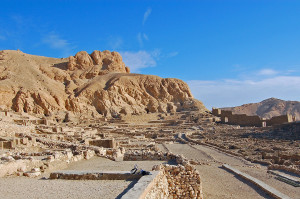Contrary to popular beliefs, Egyptian tombs, including the Great Pyramids, were not built by slaves but by workers employed by the government. When Egyptians began entombing pharaohs in the Valley of the Kings, near Luxor, they built a town about two miles away for the tomb builders and their families. The town, originally named The Place of the Truth, was founded in about 1500 B.C. and lasted until interment in the Valley of the Kings ended about 400 years later. At its peak, the town included more than 100 four or five-room stone houses.
At least some of the workers and their wives were literate. Letters written on ostraca and papyrus indicate the work schedule consisted of eight days on and two days off. Workers were given additional days off for festivals and when they were ill or, on at least one occasion, drunk. During their time off, the workers constructed chapels and tombs for themselves and their families. The government provided the houses, medical care and laundry services. Wages consisted of food, firewood and other supplies the workers needed, with occasional bonuses of items for religious celebrations and materials for their eventual mummification. The painters, stone masons, carpenters and sculptors received about three times the wages of a field hand. When the skilled workers were dissatisfied with their wages and benefits under Pharaoh Ramses III, they went on strike until their demands were satisfied.
Deir el-Medina, a UNESCO World Heritage site, includes some of the most finely decorated tombs in Egypt. It also provides an example of a government creating middle class jobs 3500 years ago.
